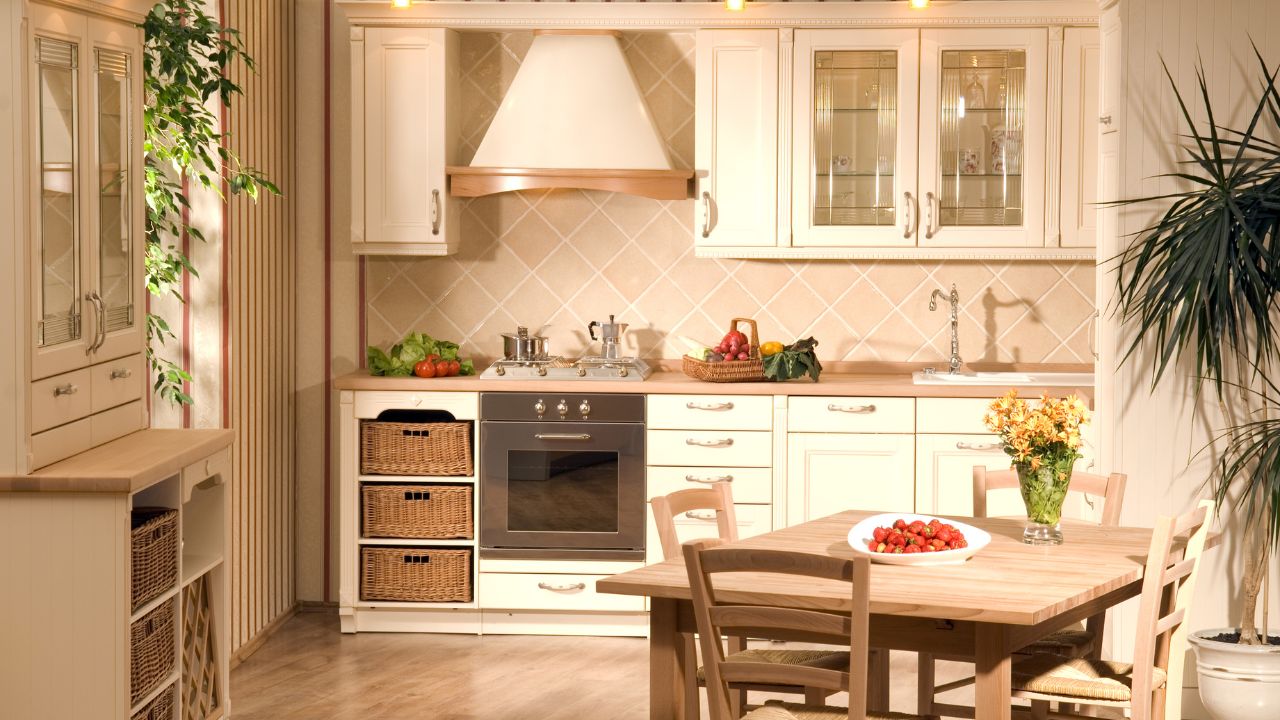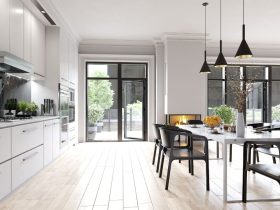When it comes to the optimal arrangement of your kitchen interior, it’s not just about finding a spot for every utensil and staple. For efficient work and to truly enjoy your kitchen, it’s essential to consider pathways as well as ergonomic and time-saving solutions. There’s nothing more frustrating than having to constantly move from one spot to another while cooking or struggling to find the desired items in an overloaded drawer. With functional and practical interior design, you’ll quickly find what you need – whether you’re planning a new kitchen or enhancing an old one.
The Best Kitchen Layout for Short Work Paths
A kitchen is divided into several zones: preparation, cooking, washing up, waste separation, and storage. For swift processes, the areas for preparation, cooking, and washing should be close to each other. Often, our clients ask whether crockery and cutlery should be stored closer to the dining table or the dishwasher. Generally, it’s convenient to keep dishes within arm’s reach of the dishwasher, making it easier to put away after washing. However, when little ones are helping set the table, a shorter walk to the dining table makes sense.
Ergonomic Work Height in the Kitchen
It’s crucial for your work surface to be spacious enough for meal prep. But even more critical is the ergonomic height of this surface. After all, you shouldn’t strain your back when chopping, stirring, or kneading. Thus, we suggest tailoring the height of the work surface to your stature. Electrical appliances, like ovens or dishwashers, should also be at a convenient height. Another tip: store heavier items neither too low nor too high. If you’re frequently bending or stretching, it can strain your back. Store items you use less often in such spots.
Sensibly Organising Kitchen Drawers
Try to place your tools and utensils in the appropriate kitchen zone, such as pots and pans near the stove, tea towels by the sink, knives and boards near the prep area, etc. There are various organising systems available for kitchen drawers, made from solid wood, plastic, or metal. Depending on your preference, these drawer inserts can also be adjustable. This helps maintain clarity and brings order to that notorious “junk drawer.” Another hint: label where items should be stored. This way, it’s clear where everything belongs – regardless of who’s unloading the dishwasher.
Kitchen Cabinets – Making the Most of Your Storage Space
Indeed, traditional kitchen cabinets offer ample storage. But depending on your kitchen’s layout, it might be worth considering other options. A pull-out pantry offers easily accessible storage and can also come in shorter versions. With a slim pull-out next to the stove, essentials like oil or the pepper mill are right at hand. And corner cabinets can make the most of otherwise wasted space, from classic lazy Susans to modern swivel solutions. Our advice: transfer spices from plastic pouches into jars – it’s tidier. Instead of buying new jars, you could use old jam jars. sink tidy
Accessories for the Kitchen Alcove – Untapped Potential
The kitchen backsplash is often seen purely as functional, protecting walls from grease and water splatters. But it can offer much more. Increasingly, kitchen manufacturers are focusing on alcove fittings. The result? Holders and shelves for knives, spices, cookbooks, utensils, and herb pots, ensuring everything you need by the stove or worktop is within reach. The backsplash also provides space for additional lighting, ensuring your work surface is perfectly illuminated with elegant light strips or spotlights.
Space-saving Storage for Kitchen Appliances
Whether it’s a food processor, mixer, blender, or rice cooker, ideally, your kitchen should accommodate your devices. But should they occupy a fixed spot on your countertop? Not necessarily. With a lifting column, you can raise the appliance out of a cabinet at the push of a button. Another alternative is a fold-out bread slicer, which can be tucked away in a cabinet drawer after use. And one more tip for perhaps the most crucial appliance: the fridge. A practical turntable solves the problem of items in the back being out of reach.













Leave a Reply